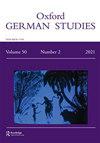克鲁修斯对利希特韦《理性法则》的视觉批判解读(1758)
IF 0.1
3区 文学
0 LITERATURE, GERMAN, DUTCH, SCANDINAVIAN
引用次数: 0
摘要
本文的重点是由莱比锡艺术家Gottlieb Leberecht Crusius为Magnus Gottfried Lichtwer的哲学说教诗Das Recht der Vernunft(1758)制作的头饰雕刻。通过对这些设计的分析,我们可以看到视觉文本是如何产生文本意义的,并作为一个标志性的镜头,以新的方式聚焦于诗歌的抽象内容。克鲁修斯在他的小插图系列中发展了一种复杂的中间解释,邀请读者-观众参与批判性反思和道德自我完善的象征性旅程。本文确立了克鲁修斯的插图代表了一种重要的元批判干预,并扩展了18世纪德国插图小插图的文本解释潜力。本文章由计算机程序翻译,如有差异,请以英文原文为准。
G. L. Crusius’s Visual-Critical Reading of Lichtwer’s Das Recht der Vernunft (1758)
This article focuses on the headpiece engravings produced by the Leipzig-based artist Gottlieb Leberecht Crusius for Magnus Gottfried Lichtwer’s philosophical-didactic poem Das Recht der Vernunft (1758). An analysis of the designs demonstrates how the visual paratexts generate textual meaning and function as an iconic lens, bringing into focus in new ways the abstract contents of the poem. Developing a complex intermedial interpretation in his vignette series, Crusius invites reader-viewers to take part in a symbolic journey of critical reflection and moral self-improvement. The article establishes that Crusius’s illustrations represent a significant metacritical intervention and expanded the text-interpretative potential of the eighteenth-century German illustrative vignette.
求助全文
通过发布文献求助,成功后即可免费获取论文全文。
去求助
来源期刊

OXFORD GERMAN STUDIES
LITERATURE, GERMAN, DUTCH, SCANDINAVIAN-
CiteScore
0.10
自引率
50.00%
发文量
2
期刊介绍:
Oxford German Studies is a fully refereed journal, and publishes in English and German, aiming to present contributions from all countries and to represent as wide a range of topics and approaches throughout German studies as can be achieved. The thematic coverage of the journal continues to be based on an inclusive conception of German studies, centred on the study of German literature from the Middle Ages to the present, but extending a warm welcome to interdisciplinary and comparative topics, and to contributions from neighbouring areas such as language study and linguistics, history, philosophy, sociology, music, and art history. The editors are literary scholars, but seek advice from specialists in other areas as appropriate.
 求助内容:
求助内容: 应助结果提醒方式:
应助结果提醒方式:


